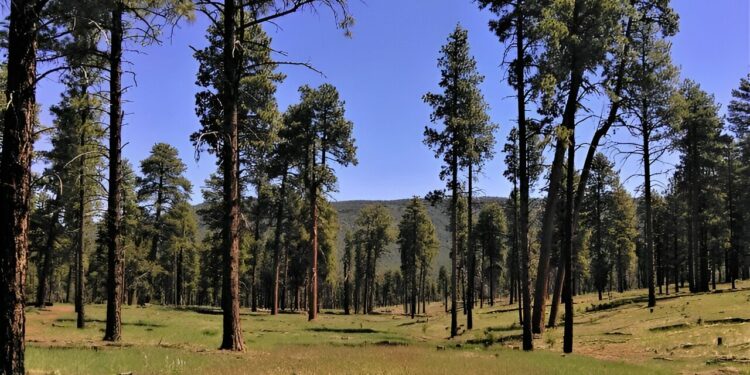What are the key factors contributing to the declining health of Ponderosa Pine forests in the United States?
Uncovering the Lasting Effects of Ponderosa Pine Restoration Treatment: A Comprehensive Study
In recent years, there has been a growing concern about the declining health of Ponderosa Pine forests across the United States. These valuable ecosystems have been negatively impacted by a range of factors, including wildfires, insect infestations, disease, and unsustainable logging practices. In response to these threats, many forest managers and conservationists have turned to restoration treatments to help rejuvenate Ponderosa Pine forests and promote their long-term health.
In this comprehensive study, we will explore the lasting effects of Ponderosa Pine restoration treatment and delve into the potential benefits it can offer for the environment, wildlife, and local communities. We will also examine some practical tips and case studies to highlight the real-world impact of these treatments.
Understanding Ponderosa Pine Restoration Treatment
Ponderosa Pine restoration treatment involves a range of silvicultural practices aimed at improving the ecological and economic health of Ponderosa Pine forests. These treatments may include selective thinning to reduce forest density, prescribed burning to mimic natural wildfire patterns, and the removal of invasive species to create healthier, more diverse forest ecosystems.
These restoration efforts are aimed at addressing the negative impacts of past management practices, such as fire suppression and excessive logging, which have disrupted the natural balance of Ponderosa Pine forests. By restoring these ecosystems to their natural state, forest managers hope to promote healthier tree growth, enhance wildlife habitat, and reduce the risk of catastrophic wildfires.
Benefits of Ponderosa Pine Restoration Treatment
The benefits of Ponderosa Pine restoration treatment are wide-ranging and impactful. Some of the key benefits include:
Forest Health: Restoration treatments can help to improve the overall health and resilience of Ponderosa Pine forests, making them more resistant to disease, insects, and catastrophic wildfires.
Wildlife Habitat: By creating a more diverse and structurally complex forest, restoration treatments can provide crucial habitat for a wide range of wildlife species, from birds and mammals to insects and amphibians.
Water Quality: Healthy Ponderosa Pine forests play a vital role in regulating water quality and quantity, helping to maintain clean, reliable water sources for both human and natural communities.
Carbon Sequestration: Mature Ponderosa Pine forests are excellent carbon sinks, and restoration treatments can help to enhance their ability to sequester carbon, mitigating the impacts of climate change.
Case Studies: Uncovering the Lasting Effects
To understand the lasting effects of Ponderosa Pine restoration treatment, let’s take a look at some real-world case studies that highlight the positive outcomes of these efforts:
Case Study 1: Black Hills National Forest, South Dakota
The Black Hills National Forest has implemented a range of restoration treatments, including thinning and prescribed burning, to improve the health of Ponderosa Pine forests. These efforts have resulted in enhanced wildlife habitat, reduced wildfire risk, and improved overall forest health.
Case Study 2: Deschutes National Forest, Oregon
The Deschutes National Forest has utilized restoration treatments to promote Ponderosa Pine forest resilience and diversity. By restoring natural forest processes, such as fire, and addressing past management practices, the forest has seen an increase in native plant and animal species.
Practical Tips for Effective Restoration
If you are interested in supporting the restoration of Ponderosa Pine forests, there are several practical tips you can follow to make a positive impact:
Support Restoration Efforts: Look for local conservation organizations and government agencies that are undertaking restoration projects and consider volunteering or donating to support their efforts.
Advocate for Sustainable Forest Management: Encourage sustainable forest management practices in your community and support policies that promote the long-term health of Ponderosa Pine forests.
Educate Others: Spread awareness about the importance of Ponderosa Pine restoration and the benefits it can offer for the environment, wildlife, and local communities.
Ponderosa Pine restoration treatment has the potential to offer long-lasting benefits for forest health, wildlife habitat, and community well-being. By understanding the importance of these restoration efforts and supporting them through practical actions, we can help to ensure the continued health and resilience of Ponderosa Pine forests for generations to come. Thank you for reading this comprehensive study on the lasting effects of Ponderosa Pine restoration treatment.
A Research Study on the Successful Restoration of Ponderosa Pine Forest
Researchers from the Ecological Research Institute (ERI) at Northern Arizona University (NAU) initiated an extensive study in 1996. Their mission was to investigate forest restoration across 5,224 acres of dense ponderosa pine forests situated on the Arizona Strip, a dry region within northern Arizona. After more than two decades of intensive fieldwork and consistent technology upgrades, the ecologists have effectively reduced tree density and the area’s susceptibility to wildfires. This significant long-term impact study has been published in the journal Restoration Ecology.
The ERI, committed to rejuvenating and safeguarding local ecosystems from harmful wildfires, has previously faced limitations that confined their experiments to smaller studies covering less than 1,000 acres. However, the western United States has experienced increasingly intense wildfires due to fire exclusion measures, resulting in overly dense forests at greater risk of drought and disease. As a result, the ERI expanded their forest restoration research to cover thousands of additional acres, following the rise in the scale of wildfires.
In 1996, when the Bureau of Land Management (BLM) proposed a collaborative study, the ERI embraced the opportunity to apply prescribed burns and mechanical tree thinning across a study site of ponderosa pine and Gambel oak forest in the Grand Canyon-Parashant National Monument. NAU researchers installed 221 permanent plots in the area and set aside about 1,200 acres as an untreated control area. Working with the BLM crew members and other fire units, they implemented tree thinning and prescribed burns until 2005.
In their study, the ERI utilized a unique thinning technique aimed at protecting older trees and restoring the landscape to its historically open conditions. Rather than consistently thinning a set number of trees per acre, they identified pre-settlement ponderosa pines and pines with specific characteristics for protection during thinning and burning. Additionally, teams arranged for the replacement of deceased historical trees following ERI’s restoration principles.
Researchers routinely tracked the forest structure, regeneration, old-tree mortality, and tree growth in the area until the study’s conclusion in 2018. The treatments resulted in a reduction of forest density by more than 50% and an almost doubled growth rate of individual trees, thus showing a newfound resilience against wildfire and favorable changes in canopy coverage beneficial for wildlife. Moreover, the study recommended that forestry managers should actively integrate fire as a restoration tool rather than relying solely on other preventative measures.
The successful implementation of prescribed burns could help identify and monitor patches of dense hardwood or vulnerable older oak trees, responding to burns based on each forest’s goals. Long-term planning is essential to ensure the effectiveness of restoration strategies in similar dry climates. The researchers also suggested that without frequent low-intensity burning, there is a risk of returning to overly dense stands.
Although there are no confirmed plans for further research at the site, the established plots from this study could be used for subsequent investigations. Potential collaborations for future investigations will involve both ERI and BLM.
Jestmore information on the ERI and ponderosa pine restoration can be obtained from their official website.
Citation:
John P. Roccaforte et al, Long‐term ecological responses to landscape‐scale restoration in a western United States dry forest, Restoration Ecology (2024). DOI: 10.1111/rec.14181






